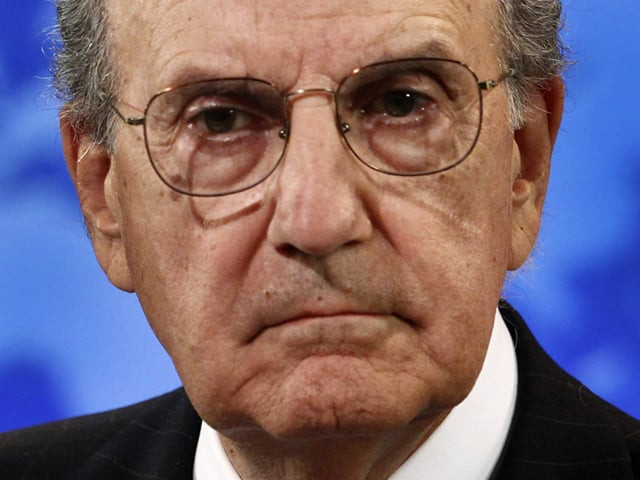The Hamas-Fatah reconciliation deal that concluded on April 27, 2011, was a good omen for the stalled Palestine peace process. Both factions displayed commitment to resolve the outstanding issues and reached an agreement on forming an interim government for holding of legislative and presidential elections. But the news of the resignation of George Mitchell as US Envoy in Middle East dashed the hopes of any progress on the peace front.
Mitchell enjoyed the reputation of being a “tireless advocate” of peace, but his extraordinary skills failed in the face of Israeli obduracy. A few days ago, US President Barrack Obama called for a peace plan for Palestine based on the return to 1967 borders. This speech annoyed Netanyahu who has, in no ambiguous terms, rejected Obama's stance.
Unfortunately the Palestine problem remains as intractable today as it was six decades ago. Rather in many respects it has become more complex and intricate. An understanding of the protracted conflict will require answers to two questions.
One, what are the fundamental thorny issues bedevilling the relationship of the disputants?
And two, why have all peace initiatives, undertaken over the past decades, come to naught?
The dispute
The core contentious issues of long-standing Arab-Israeli conflict include the status of East Jerusalem, Israeli settlements, right to return of refugees and appropriation of natural resources.
The territory of East Jerusalem is sacred for Judaism, Christianity as well as Islam. Both Israelis and Palestinians lay claim to Jerusalem as their capital. It came under occupation of Israel after the Six Day War of 1967.
Israel has concerns regarding its religious places present in East Jerusalem, as during Jordanian control, Jews were not allowed to visit Jewish sacred places and a Jewish cemetery was desecrated. Moreover, Israel is also apprehensive regarding the security of its residents as they have been victims of firing from Arab areas many times in the past. The Palestinians also have legitimate grievances regarding welfare of their sacred sites under Israeli control.
During a period spanning four decades, Israel has also established its communities in the occupied territories of West Bank and East Jerusalem. In 2006 a unilateral disengagement plan was mapped out by Ariel Sharon and all settlement buildings were demolished in the Gaza strip. But Israel has pressed ahead with its policy of building settlements in West Bank. Most of these lie in the western part of West Bank and deep into Palestinian territory dividing the Palestinian population.
The settlements are also the cause of great inequalities in access to natural resources between Israelis and Palestinians. Many settlements are built on fertile agricultural lands confiscated from Palestinians or on water resources like the Western Aquifer Basin. The Palestinians consume almost 80 litres per day per person whilst the Israeli settlers consume above 250 litres per day. Israel receives much of its water from two aquifers, Western and North Eastern aquifers, sprawled across the Green Line. The Palestinians want that their society be contiguous and have sufficient resources to have an economically viable state.
It goes without saying that multifarious efforts to promote peace in the Middle East have failed primarily because of mistrust and suspicion existing between the parties. In the absence of mutual trust and confidence, peace remains elusive as the contracting parties succumb to their imaginary lingering fears. Israel views an independent Palestine state as a vital threat to its existence, while the Arabs are under the threat of Al Naqba (the catastrophe). The demagogue and hawkish elements on both sides have missed no opportunity to hamper the steady progress of peace negotiations. At the same time the unconditional support extended to Israel by the West has encouraged the former to adhere to an inflexible, rigid stance. Thus there is need to free the peace process from being hostage to militants’ extremist agenda.
Steps to take
In order to reach an agreement envisioning an amicable solution to the dispute, the leaders of both parties must break their pre-formulated moulds and get ready for out-of-box thinking.
Israel must face the reality of the Palestinians’ right to self-determination and get rid of its historical attitude of blindness and denial, as the Palestinians are motivated by the slogan Thaura Hat al Nasr (revolution till victory). Israel must do with the condition of recognition of Israel as Jewish state by Palestinians as a pre-requisite to kick-start the genuine peace process.
The UN resolutions coupled with the Arab peace plan propounded by the Saudi King in 2002 could provide guidelines for future peace roadmap.
The Palestinians should also end all internal dissensions if they want to bring peace to the strife-torn region.
The Obama administration should pressurise Netanyahu government to soften its hard-line stance and push Israel towards two-state solution.
Mideast peace process: Hampered throughout history
The Palestine problem remains as intractable today as it was six decades ago.



COMMENTS
Comments are moderated and generally will be posted if they are on-topic and not abusive.
For more information, please see our Comments FAQ